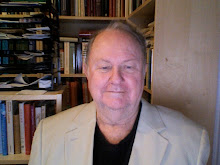At the outset the instructor reported on his visit to St. Thomas Episcopal church (Fifth Ave. at 53d St.), previously introduced as an example of the mature Gothic Revival mode. In keeping with his recollection, the interior proved to be AC (Archaeologically Correct), with a tripartite elevation surmounted by rib vaulting. The end of the chancel was dominated by a humongous, sculpture-crowded reredos, providing a backdrop for the service. The latter, in keeping with High Anglican tradition, was something of a Cecil B. DeMille production, with processions, choral and organ music, and much rising, sitting, and kneeling on the part of the congregation. The building reflects the confluence of two 19th-century trends in England: Pugin's reforms and propaganda; and the Oxford movement. (See Brooks for further information.)
By way of a prelude to a return to the subject of RUINS in art, the discussion turned to the aestetic problem of the fragment, beginning with the powerful piece known as the Belvedere torso, eulogized by Sir Joshua Reynolds for its "perfection of the science of abstract form." A head from St.-Denis, severed in the 18th century, attests the role of vandalism (or restoration) in the creation of sculptural fragments. Rodin created ex-novo fragments, such as his "Striding Man." Some modern works, as the Cezanne watercolor. seemingly unfinished, appeal to the "beholder's share." Hence the nonfinito problem, one that does not seem to lend itself to any sort of definitive solution.
While there are occasional depictions of ruins in medieval manuscript illuminations, the subject does not really get off the ground until the Italian Renaissance, with its fascination with classical remains. In my view the role of ruins in Mantegna's Vienna St. Sebastian remains enigmatic-- a personal penchant? A symbol of the end of classical civilization? a counterpart of the plague? or a trope fo the breaking of Sebastian's body? (He was later stoned.) Similarly the ruins in Giorgione's "Tempesta" remain puzzling, though perhaps the new explanation by Jurgen Rapp (the figures as Paris and Oenone) may work.
(Btw, there is a recent coffee-ta le book on ruins in art by Michel Makarius, available at the Met at a reduced though still high price.)
During the 18th century the depiction of classical ruins took on a new pathos, as seen in works by Robert and Piranesi. These bring us to the life-changing experience of Edward Gibbon. In his own words: "It was at Rome, on the eighteenth of October, 1764, as I sat musing amidst the ruins of the Capitol, while the barefooted friars were singing vespers, at the Temple of Jupiter, that the idea of wriging the decline and fall of the City first started in my mind." The first installment of Gibbon's great work appeared in 1776. Essentially presenting the era as a prelude ot the Dark Ages, it served to retard the appearance of a more balanced approach to the era. Only by implication does Gibbon adduce a more general oomparative theory. Such, however, was presented in the 1830s by Thomas Cole in his five-part series "The Course of Empire" (New-York Historical Society). In 1918 Oswald Spengler brought out the first volume of "The Decline of the West," a full-dress exposition of the trope of the inevitable life-cycle of civilizations. Today, once again, historians and pundits are asking if we are about to reproduce the fate of ancient Rome.
In 1809 and after C.D. Friedrich transformed the theme of the pathos of ruins to apply to the Middle Ages. In keeping with a theme of the Romantic movement, his images of ruins are intended to evoke a sense of irreparable loss (a loss that Pugin later held he could in fact cure).
The theme of ruins invites many reflections. Ruins are caused in four ways: enemy action, despoliation, neglect, and deliberate creation (fakes).
In 19th century France the term for Gibbon's problem was decadence. As seen in Thomas Couture's 1847 painting, this expression was originally applied to the more distant (Roman) past. After the defeat of 1871 the term was actualized--hence the Decadent Movement, whose most prominent figure was Paul Verlaine. The adoption of the term "decdaent" illustrates the curious theme of "detoxification of terms, as seen e.g. in the "queer" trend and the Hollywood Rat Pack. Huysmans' novel "Against Nature" shows a genuine appreciation of the literature of late antiquity. This seems to be the first instance of a positive approach to the cultural products of this much-disparaged era. A little later the Viennese historians were to extend the approach to art works.
Thursday, September 13, 2007
Subscribe to:
Post Comments (Atom)

No comments:
Post a Comment